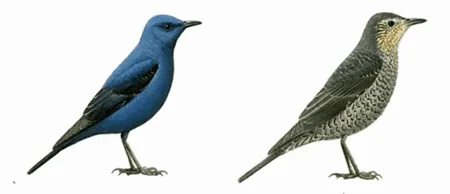
Blue Rock Thrush
[order] PASSERIFORMES | [family] Muscicapidae | [latin] Monticola solitarius | [UK] Blue Rock Thrush | [FR] Merle bleu | [DE] Blaumerle | [ES] Roquero solitario | [NL] Blauwe Rotslijster
Subspecies
| Genus | Species | subspecies | Breeding Range | Breeding Range 2 | Non Breeding Range |
| Monticola | solitarius | EU, OR | widespread, also nw Africa | ||
| Monticola | solitarius | longirostris | |||
| Monticola | solitarius | madoci | |||
| Monticola | solitarius | pandoo | |||
| Monticola | solitarius | philippensis | |||
| Monticola | solitarius | solitarius |
Physical charateristics
Shape, stance, and habits much as Rufous-tailed Rock-Thrush, but noticeably bulkier with longer tail. Plumage dark and relatively uniform at all ages and seasons.
Male dusky blue, in spring dull slate blue, with black tone strongest on back, wing, and tail. Female mottled dusky, dark grey-brown, with little visible blue tone and more obviously marked than male. Sexes dissimilar little seasonal variation.
Male dusky blue, in spring dull slate blue, with black tone strongest on back, wing, and tail. Female mottled dusky, dark grey-brown, with little visible blue tone and more obviously marked than male. Sexes dissimilar little seasonal variation.
Listen to the sound of Blue Rock Thrush
[audio:http://www.aviflevoland.nl/sounddb/B/Blue Rock Thrush.mp3]
Copyright remark: Most sounds derived from xeno-canto
| wingspan min.: | 33 | cm | wingspan max.: | 37 | cm |
| size min.: | 21 | cm | size max.: | 23 | cm |
| incubation min.: | 12 | days | incubation max.: | 15 | days |
| fledging min.: | 0 | days | fledging max.: | 15 | days |
| broods: | 1 | eggs min.: | 4 | ||
| eggs max.: | 6 |
Range
Eurasia, Oriental Region : widespread, also Northwest Africa
Habitat
Breeds in W Palearctic in middle and lower middle latitudes in warm dry temperate, Mediterranean and steppe climatic zones, montane and coastal, rocky and nearly always in part precipitous. Occupies mountains from foothills to juniper zone, especially on precipitous rocky slopes above mountain streams, and on rocks strewn through forests, or sotne fields with thick shrub growth and scattered trees at low as well as high altitudes.
Reproduction
May-June in Iberia, April-May in North-West Africa, March in Malta, June in former Yugoslavia. Nest site is built in hole or crevice in cliff, under overhanging rock, in cave or quarry, in wall of old building, occasionally in horizontal drainage pipe or hole in tree.
Nest is a rather bulky but loosely built shallow cup of coarse dry grass, moss, and some roots, lined with softer and finer roots, and grasses, occasionally with feathers and plant down.
4-5 eggs, incubation 12-15 days, tended to mainly by female.
Nest is a rather bulky but loosely built shallow cup of coarse dry grass, moss, and some roots, lined with softer and finer roots, and grasses, occasionally with feathers and plant down.
4-5 eggs, incubation 12-15 days, tended to mainly by female.
Feeding habits
Mainly invertebrates, also lizards and plant material. Feeds on ground, by pouncing on prey from perch, and by making short chases after flying prey.
Conservation
This species has an extremely large range, and hence does not approach the thresholds for Vulnerable under the range size criterion (Extent of Occurrence <20,000 km2 combined with a declining or fluctuating range size, habitat extent/quality, or population size and a small number of locations or severe fragmentation). The population trend appears to be stable, and hence the species does not approach the thresholds for Vulnerable under the population trend criterion (>30% decline over ten years or three generations). The population size is very large, and hence does not approach the thresholds for Vulnerable under the population size criterion (<10,000 mature individuals with a continuing decline estimated to be >10% in ten years or three generations, or with a specified population structure). For these reasons the species is evaluated as Least Concern.
Monticola solitarius is a widespread but patchily distributed breeder in southern
Europe, which accounts for less than half of its global breeding range. Its European
breeding population is large (>120,000 pairs), but underwent a large decline between
1970-1990. The species was stable across most of its European range during 1990-
2000?including the key Turkish population?and thus was probably stable overall.
Nevertheless, its population size has not yet recovered to the level that preceded its
decline.
Monticola solitarius is a widespread but patchily distributed breeder in southern
Europe, which accounts for less than half of its global breeding range. Its European
breeding population is large (>120,000 pairs), but underwent a large decline between
1970-1990. The species was stable across most of its European range during 1990-
2000?including the key Turkish population?and thus was probably stable overall.
Nevertheless, its population size has not yet recovered to the level that preceded its
decline.

Migration
Partially migratory in west Palearctic (extralimitally in eastern Asia primarily migratory). Vertical displacements common. Main wintering areas of migrants lie in North Africa and Arabia. Migrates singly or in loose aggregations, primarily at night, often with Rock Thrush. Timing of movements poorly known; passage rarely observed, even in Mediterranean basin, and difficult to distinguish between long-distance migration and local dispersal. Vagrants occur north of breeding range as far as Sweden. Most records in August or early September, suggesting reverse migration.
Distribution map

